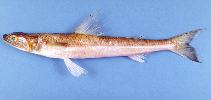| Family: |
Synodontidae (Lizardfishes), subfamily: Harpadontinae |
| Max. size: |
50 cm SL (male/unsexed); max. reported age: 7 years |
| Environment: |
reef-associated; marine; depth range 1 - 350 m, amphidromous |
| Distribution: |
Eastern Indian Ocean, Malay Peninsula, southern Philippines, northern Java, Arafura Sea, Louisiade Archipelago, and northern half and southwestern Australia. Reports of Introduction in the Mediterranean are questionable. Confirmed and questionable reports of its occurrence (and references) are discussed in Inoue & Nakabo 2006 (Ref. 57869:385-6). |
| Diagnosis: |
Dorsal spines (total): 0-0; Dorsal soft rays (total): 11-12; Anal spines: 0-0; Anal soft rays: 11-12. Cigar-shaped, rounded or slightly compressed; the head pointed and depressed; the snout rounded. Dorsal origin closer to the adipose origin than the snout tip. Anal fin origin is closer to the tail base than the operculum. Color is brown-gray above and creamy below, with 8-10 indistinct darker spots along the middle of the sides. |
| Biology: |
Found on the sublittoral zone above 100 m over sand or mud bottoms of coastal waters (Ref. 11228, 11230). Feeds on fishes (anchovy and red mullet Mullus surmuletus), crustaceans, and other invertebrates (Ref. 5213). Spawns from April to May off Japan. Generally marketed frozen, sometimes fresh and as fish cakes ('kamaboko') in Japan (Ref. 4964). Minimum depth from Ref. 12260. |
| IUCN Red List Status: |
Least Concern (LC); Date assessed: 02 March 2015 Ref. (130435)
|
| Threat to humans: |
harmless |
Source and more info: www.fishbase.org. For personal, classroom, and other internal use only. Not for publication.

